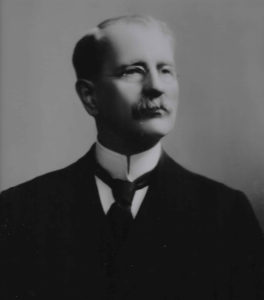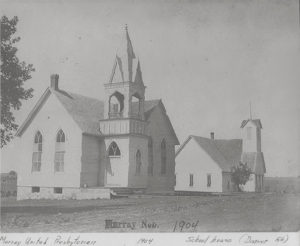Murray Presbyterian:
The church that gave the village its name.
Beginnings in Rock Bluff
The spiritual roots of Murray Presbyterian Church go back to the former United Presbyterian Church of North America, a small, predominantly Scots-Irish body of Presbyterians renowned for its missionary zeal and commitment to maintaining the truth of God’s Word in a spirit of love. In May, 1860, the third General Assembly of this newly-formed denomination appointed 31-year old Rev. Thomas McCartney, a native of Ireland and recent seminary graduate, to serve as a frontier missionary in Rock Bluff, Nebraska. Nebraska Territory was only six years old at this point, and Rock Bluff had become an important Missouri River steamboat town and staging area for settlers moving farther westward. On August 18, 1860, just one month after his arrival, Rev. McCartney conducted a service organizing nine charter members into the congregation that would subsequently become Murray Presbyterian Church.
After initially meeting in the schoolhouse, the church members acquired an acre of timber in Iowa, felled trees, and ferried the logs across the river to construct a house of worship. Topped off with a copula holding a 400 lb. bell, the structure was, according to one contemporary newspaper account, “the first church building of the kind to be erected in Cass county.”
A New Start on the Prairie
Rock Bluff continued to flourish for a while, even rivaling Plattsmouth at one point for the distinction of being the county seat. But when it was bypassed by the railroads and by new bridges spanning the Missouri River, it entered a period of decline. (By the 1940’s it was a ghost town.) Perhaps sensing this trend, the Presbyterians decided in 1878 to move their house of worship four miles east to “a central place on the prairie.” This they accomplished by disassembling the building and moving it by wagon to a piece of property donated by James Walker, a former resident of Rock Bluff who had acquired a large tract of farmland. A sign hung from the reconstituted structure identified it as “Fairview United Presbyterian Church, 1878”–taking the place name of the crossroads where it was now located.

A Pastor Gives the Town Its Name
By 1884, the settlement around the Presbyterian Church building consisted of the schoolhouse next door, a blacksmith shop, and two private dwellings. In that year, a post office was established in the blacksmith shop. Since there was already a Nebraska town called Fairview, the community had to come up with a new designation. The name “Murray” was chosen in honor of Rev. George Reed Murray, who had become the Presbyterian Church’s first resident pastor four years earlier. A native of Western Pennsylvania and a Civil War veteran, Rev. Murray served our church from 1880-1890 (the second-longest tenure in the church’s history). As the town history notes, “Rev. Murray was a beloved member of the community. . . [He] was popular in a much wider circle than the membership of his church. . . His power for good impressed many who never attended his church.”
A Growing Ministry
Though it may have been a rural village church on the prairie, Murray Presbyterian was a place where God’s Spirit was mightily at work. One family history tells the story of Rev. S. S . Stewart, invited to become pastor of the Murray church in 1893. Though he was only in his 40’s, his health was failing and he was reluctant to serve what was described as “a small mission station of about 30 members in a village of about 50 people.” After initially declining the call, he “later decided that God had called him to the Murray field.” The outcome confirmed this sense of direction: “It was a rare sight to behold when at an evening meeting in that little mission, more than 30 persons, nearly all of whom were heads of families, stood up confessing Christ and, by the rite of baptism, were received into the church.”
Within five years, what had been a small mission station with 30 members was approaching a membership of 100 and outgrowing its original house  of worship.
of worship.
 of worship.
of worship.To accommodate this growth, a new sanctuary building was constructed and dedicated on May 29, 1898. This edifice still serves as our place of worship–modified by the installation of stained glass windows in 1943 and a new chancel area in 1953. In connection with the 1953 renovations, a new 2-story Sunday School / fellowship hall wing was added on. This portion of the facility was enlarged in 1999 to include a new kitchen, office, and additional Sunday School rooms downstairs.
New Challenges – New Opportunities
In 1958, the United Presbyterians merged with the main body of Presbyterians in America to form the denomination now known as the Presbyterian Church (USA). And while Murray Presbyterian’s historic spiritual home was being assimilated into a larger denomination, the community around the church was being assimilated into the greater Omaha metropolitan area. The declining farm population initially posed challenges to the congregation. But the Beaver Lake development on the other side of Route 75 brought a fresh influx of new members. And a generous bequest from the estate of Dr. John E. Gilmore provided a measure of financial stability. Today’s congregation is grateful for the rich heritage of faith that has been passed along to us, and eager to embrace the future ministry opportunities that God will give us.
“For the Lord is good and his love endures forever; his faithfulness continues through all generations.” Psalm 100:5 (New International Version)
